AI detection systems are getting smarter every day, creating new hurdles for content creators who use AI tools in their workflow. Whether you’re writing blogs, creating marketing materials, or optimizing for SEO, knowing how to create AI-assisted content that flies under the radar has become a valuable skill. Let’s explore some proven strategies to bypass AI detection while still writing quality content that delivers real value.
Quick Start Guide: Essential AI Detection Bypass Techniques
Need solutions right now? Here are the most effective ways to make your AI-assisted content read like it’s human-written:
- Mix up your sentence structure and length – Switch between short, punchy sentences and longer, flowing ones
- Stick with active voice most of the time – Ditch passive constructions for more direct, action-oriented language
- Throw in personal stories and insights – Share your unique experiences and viewpoints
- Edit AI outputs by hand – Rework paragraphs, add smooth transitions, and fine-tune word choices
- Check with multiple detection tools – Run your content through Originality.ai and GPTZero before publishing.
Now let’s dig deeper into this topic.
What does “bypass AI detection” mean?
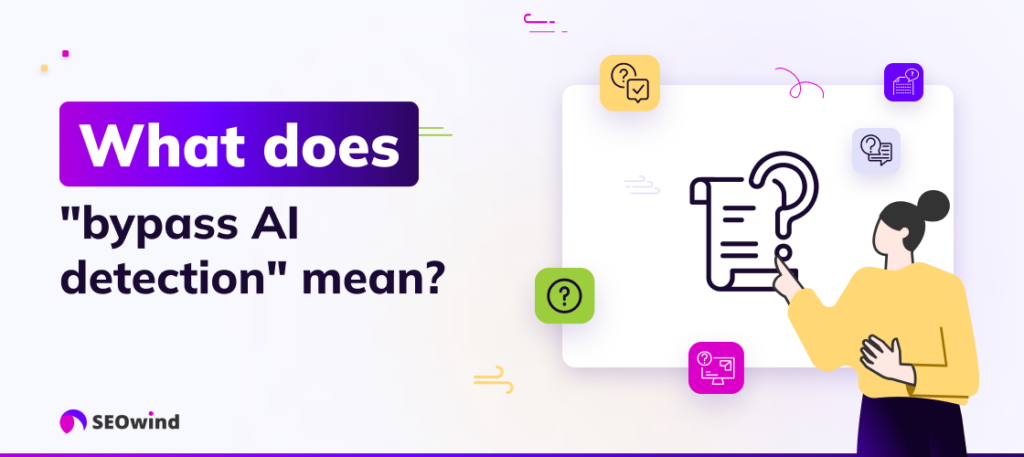
Bypassing AI detection means making your content appear so seamless that AI cannot determine whether it was created by humans or an automated tool. It’s about employing innovative strategies that camouflage any trace that may hint toward automation.
What Does “Bypass AI Detection” Really Mean?
When we talk about bypassing AI detection, we’re not trying to pull a fast one on detection systems. Instead, we’re aiming to create natural, human-sounding content that has been created with AI assistance. The goal is to produce high-quality, authentic content that genuinely helps readers while seamlessly incorporating AI tools into your creative process.
How AI Detection Systems Function
Before jumping into specific techniques, let’s look at how modern AI detection systems actually work and what they can (and can’t) do.

Source: Giphy
AI detectors use sophisticated algorithms designed to spot patterns typically found in machine-generated text. These systems analyze content using several key approaches:
- Perplexity and Burstiness Analysis: Tools like GPTZero look at how predictable text is (perplexity) and how much it varies in sentence structure (burstiness). Human writing tends to be more “bursty” with greater ups and downs in sentence complexity compared to AI’s more uniform patterns.
- Stylometric Analysis: Detectors analyze stylometric features – unique patterns in word choice, sentence structure, and other linguistic quirks that set human writing apart from AI-generated content.
- Multiple Detection Algorithms: Top tools now use up to six different AI-based detection algorithms at once to improve accuracy and overcome the limitations of using just one approach.
Insight into How AI Detects Content
AI identifies anomalies or patterns based on its programmed algorithms. The primary hints it looks for include frequent use of specific keywords and phrases, repetitive sentence structures or formatting, and unusual use of punctuation marks. These AI investigators not only focus on text but also detect discrepancies in images and audio.
According to Stanford University researchers, modern recognition systems are trained using thousands of labeled examples, such as speech snippets linked to transcripts or photos associated with descriptions. This process enables them to identify elements such as faces in images and words in speeches.
However, AI detection systems aren’t flawless. The accuracy of AI detection tools is often limited by the training data they’ve been exposed to, leading to potential false positives and negatives. In addition, AI content detection tools have shown variability in their ability to accurately identify content generated by different versions of AI models, such as GPT 3.5 and GPT 4. The tools were generally more accurate in identifying content generated by GPT 3.5 compared to GPT 4 (International Journal for Educational Integrity).
Current AI Detection Tool Performance
Independent research shows significant differences in how well these tools work:
Detector limitations: Several independent academic studies from 2023-2024 warn that AI detectors often misclassify both human and AI texts, especially after even minor editing. When AI-generated text gets even light editing, detector accuracy can plummet by over 54% in some cases.
Originality.ai: Claims 98% accuracy for detecting AI-generated content with false positives under 1%. However, they caution against taking accuracy claims at face value without context, as real-world performance varies widely.
GPTZero: In a February 2024 ZDNet test, GPTZero correctly identified AI-generated text 98% of the time. But broader academic research shows that GPTZero, like other detectors, struggles with content that’s been paraphrased or lightly edited.
Turnitin: Despite company claims of high accuracy, academic sources indicate Turnitin has the same limitations as other detectors, especially with hybrid content that mixes human and AI writing.
10+ Strategies for Bypassing AI Detection in 2025

These practical techniques will help you create content that maintains a human touch while having AI assistance effectively.
Strategy 1: Rephrase sentence structure and format
AI detectors look for predictable writing patterns. You can break these patterns by varying your sentence structure throughout your content. Mix short, punchy sentences with longer, more complex ones to create a natural rhythm that sounds human.
Before: “AI detection tools analyze content patterns. These tools look for repetitive structures. They flag content that appears machine-generated.”
After: “Modern AI detection tools analyze content for telltale patterns—repetitive structures, predictable transitions, and other markers that suggest machine generation. Some detectors are remarkably sophisticated, yet your content can maintain its natural, human-written quality with the right approach to sentence variation.”
Strategy 2: Use an Active Voice
AI often defaults to passive construction, while human writers prefer active voice. Focus on active voice to make your writing more readable and sidestep AI detection algorithms that flag passive-heavy content.
Before: “The report was generated by the AI system and was distributed to team members.”
After: “The AI system generated the report, which our team then reviewed and distributed among departments.”
Strategy 3: Simplify Your Writing
Surprisingly, simplicity often confuses AI detectors. Many systems are trained on academic and professional text, so straightforward, clear language can appear more human. Aim for clarity instead of complexity and skip unnecessary jargon.
Strategy 4: Vary Punctuation and Whitespace
AI tends to follow consistent patterns with punctuation and spacing. By naturally varying your use of commas, periods, and paragraph breaks, you create a more authentic writing style that’s harder for detection systems to flag.
Strategy 5: Use Thoughtful Synonym Variation
Clever use of synonyms helps avoid the repetitive language patterns that AI detection systems notice. Rather than mechanically swapping words, think about what fits best in context to keep the flow natural.
Before: “The project was completed successfully. The project met all requirements. The project finished under budget.”
After: “We successfully wrapped up the initiative, meeting all requirements while coming in under budget. The entire undertaking proved more efficient than initially projected.”
Strategy 6: Avoid Keyword Repetition
AI detectors are great at spotting repetitive language patterns, especially with keywords. Instead of using the same terms repeatedly, spread them naturally throughout your article and use variations that mean the same thing.
For example, let’s say your focus keyword is “bypass AI detection.” Try using alternatives like “avoid artificial intelligence detection” or “circumvent machine learning monitoring.” This diversifies your writing and improves readability by preventing redundancy!
Strategy 7: Craft Expert-Level Prompts
The quality of what you put in largely determines what comes out. Instead of basic prompts, give detailed context and specific instructions.
Basic prompt: “Write about hiking boots.”
Expert prompt: “Write a comprehensive guide for experienced hikers comparing waterproof leather versus synthetic hiking boots for multi-day alpine treks, incorporating durability factors, weight considerations, and price-to-performance ratio. Include personal insights from someone who has tested both types on challenging terrain.”
Strategy 8: Use your brand voice and tone
Consistency in brand voice makes content feel authentically yours. Whether your brand is formal and corporate or casual and conversational, keeping this voice consistent helps humanize your content.
SEOwind users can customize their AI’s writing style by setting tone-of-voice guidelines within the tool, helping maintain brand consistency even when working with AI.
Strategy 9: Implement Human Editorial Review
There’s no alternative to the good ol’ human touch! Having a skilled editor review AI-generated content can transform it from mechanical to masterful by:
- Checking facts and ensuring logical flow
- Fixing subtle errors and inconsistencies
- Adding depth and nuanced perspectives
- Creating emotional connections with readers
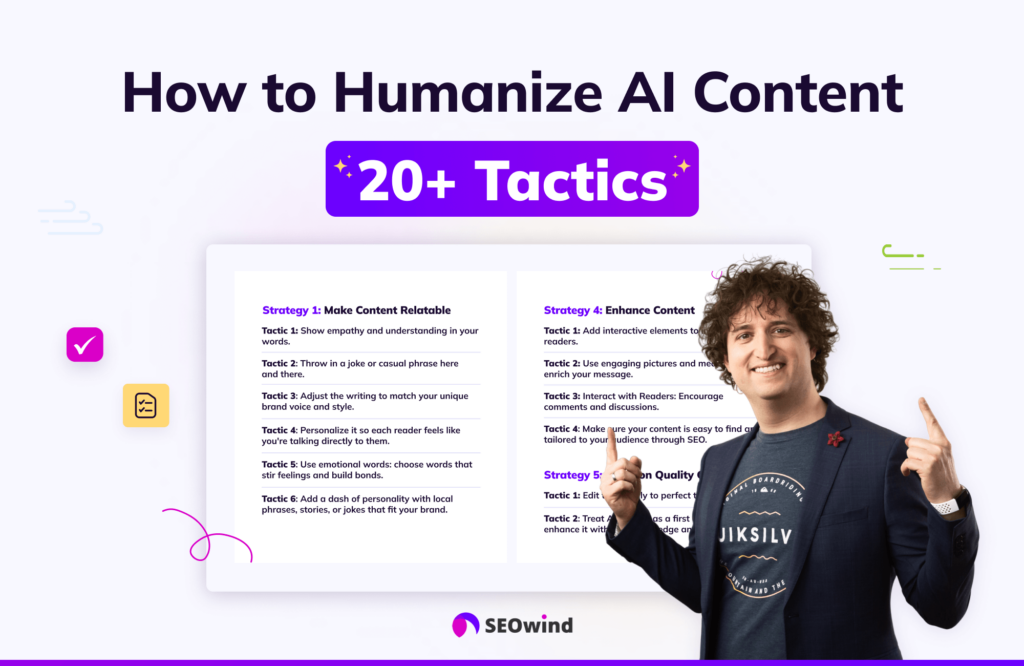
Strategy 10: Incorporate Original Expertise
AI tools work best as assistants rather than authors. You create content that no AI can duplicate by adding your unique insights, experiences, and industry knowledge.
For instance, a financial advisor might enhance an AI-drafted retirement planning article with specific client scenarios they’ve handled, creating a richer, more valuable resource that easily passes detection.
Strategy 11: Include personal stories and anecdotes
Personal stories create an unmistakable human element in your content. By weaving in relevant anecdotes that connect to your topic, you bypass AI detection and build stronger connections with your audience.
Bonus Strategy: CyborgMethod™ – The Ultimate Method to Avoid AI Detection

Beyond individual techniques, the CyborgMethod™ offers a comprehensive framework for creating content that seamlessly blends AI efficiency with human creativity. This systematic approach helps bypass AI detection and results in higher-quality content.
1. Create a Comprehensive Brief
Start with thorough research and develop a detailed content brief that includes:
- Clearly defined objectives
- Audience insights
- Topic scope and boundaries
- Key points to cover
- Desired tone and voice
- Examples and analogies to include
This foundation sets clear parameters for AI assistance while establishing your human direction from the outset.
2. Create AI articles based on Research
Leverage AI to create initial drafts based on your comprehensive brief. The key is to use AI as a starting point, not a finished product. Quality inputs produce quality outputs, so feed the AI with:
- Unique perspectives
- Your specific expertise
- Proprietary data points
- Industry-specific terminology
3. Use AI tools that are focused on research
Invest in elaborate and dynamic AI tools primarily focused on conducting research, like Semrush, SEOwind, Clearscope, or even Frase’s SEO toolset. Each provides closely related topics or ideas about the subject at hand. These solutions broaden the array of options available while crafting unique content.
Technological advancements have also developed tools capable of detecting plagiarism. Use them wisely to determine if any section of your draft matches online content that already exists so you can make the necessary alterations.
Give it the human touch
The final and most crucial step is thorough human editing and enhancement. This includes:
- Adding humor, emotion, or other human elements
- Restructuring awkward phrasing
- Adding personal anecdotes and examples
- Incorporating industry-specific insights
- Fact-checking all information
- Ensuring consistent tone and voice

The magic of bypassing even the most sophisticated AI lies within this delicate blend of human creativity and AI efficiency. Your journey will encompass technological mastery and appreciation of natural human intelligence.
Real-World Success: Business Case Studies
Several companies have successfully integrated AI-generated content into their marketing strategies without detection issues, maintaining high quality and strong search performance:
Netflix: Personalized Content Recommendations
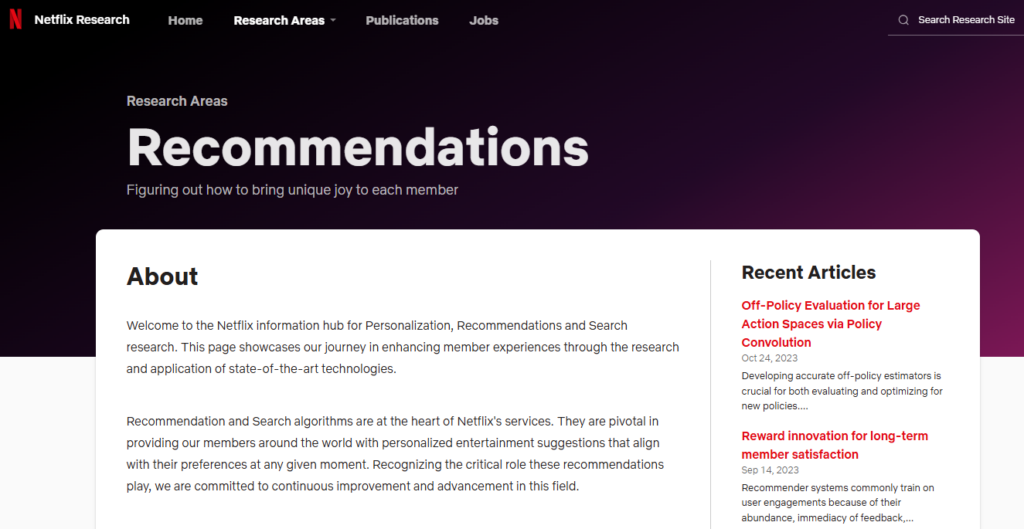
Netflix uses advanced AI algorithms to analyze viewer behaviors and dynamically select content recommendations and thumbnails. This AI-driven approach has resulted in over 80% of content viewed on Netflix coming from its recommendation engine. The personalization makes AI intervention virtually undetectable by both users and search engines.
Coca-Cola: AI-Powered Marketing Content

Coca-Cola adopted an AI platform called Albert to autonomously create, test, and optimize digital marketing content. The AI generates ad copy, images, and campaign adjustments in real time. According to digital transformation case studies, Coca-Cola reported increased digital ad performance with content indistinguishable from manually crafted ads.
Heinz: AI-Generated Creative Campaigns
Heinz utilized AI models (including DALL·E) to generate ad imagery and campaign concepts. The AI-generated campaigns achieved higher engagement rates compared to traditional campaigns. The distinctiveness and quality of the AI content enabled Heinz to maintain brand voice while achieving better-than-average results.
Key Techniques Used by These Companies
- Continuous optimization: These systems employ ongoing data analysis and feedback loops
- Personalization algorithms: Adapting content to individual preferences helps reduce detectable patterns
- Human-AI collaboration: Using a mix of human review and automated refinement
- Dynamic content adjustment: Real-time modification based on performance metrics
Comprehensive Comparison of Top AI Detection Tools (2025)
Understanding the capabilities and limitations of popular AI detection tools helps inform your content creation strategy:
| Tool | Accuracy Claims | Detection Method | Key Strengths | Notable Limitations |
|---|---|---|---|---|
| Originality.ai | 98-99% | Multiple algorithms, stylometric analysis | Low false positive rate (<3%), excellent at detecting GPT-3.5 content | Subscription required, less effective with heavily edited text |
| GPTZero | 98% (ZDNet test) | Perplexity and burstiness analysis | Free option available, additional writing analysis features | Limited accuracy with mixed human/AI content, high false positives with edited content |
| Turnitin | Not independently verified | Pattern matching, stylistic analysis | Established in academic settings | High false positive rate, struggles with contextual content |
| ZeroGPT | Not reported | Linguistic pattern analysis | Free to use, simple interface | Less accurate than premium alternatives |
Comprehensive Tool Comparison for Creating Human-Like AI Content
| Tool | Main Features | Best For | Best For | Pricing |
|---|---|---|---|---|
| SEOwind | AI Article Writer with research integration and AI agents, CyborgMethod™ framework, SEO optimization | Long-form content, SEO articles, comprehensive blog posts | Mainly for long form articles | Subscription-based |
| GPT Humanize AI | Specialized for humanizing content, focuses on conversational tone | Quick content edits, making existing AI content more natural | Limited research capabilities | Free with ChatGPT Plus |
| QuillBot | Advanced paraphrasing, synonym suggestions, tone adjustments | Rewording existing content, improving readability | Limited original content generation | Free basic version, Premium subscription |
| Grammarly | Style suggestions, tone detection, clarity improvements | Editing, refining existing content | Not designed specifically for AI humanization | Free basic version, Premium subscription |
| Jasper | Templates, brand voice customization, team collaboration | Marketing copy, brand-consistent content | Less specialized for bypassing detection specifically | Subscription-based |
Ethical Considerations and Google’s Position
Google’s Official Stance on AI-Generated Content
Google has made it clear that they care about content quality, not how it’s made. According to their February 2023 blog post, “Our focus on the quality of content, rather than how content is produced, is a useful guide that has helped us deliver reliable, high-quality results to users for years.”
Google further explained that using AI isn’t inherently a problem: “Appropriate use of AI or automation is not against our guidelines. This means that it is not used to generate content primarily to manipulate search rankings, which is against our spam policies.”
They doubled down on this position in March 2024, when Google updated its ranking systems to tackle low-quality content. The update aimed to “Refine some of our core ranking systems to help us better understand if webpages are unhelpful, have a poor user experience or feel like they were created for search engines instead of people.”
By April 2024, Google announced they’d completed these changes with even better results than expected: “As of April 19, we’ve completed the rollout of these changes. You’ll now see 45% less low-quality, unoriginal content in search results versus the 40% improvement we expected across this work.”
Academic Integrity Concerns
In academic settings, using AI-generated content without permission might break institutional rules. Many universities now have specific guidelines about AI use in their academic integrity policies, potentially treating undisclosed AI assistance as plagiarism.
While there haven’t been many high-profile cases of students being disciplined solely for using AI-generated content disguised as their own work in 2023-2024, students and researchers should always follow their institution’s specific policies on AI usage.
Best Practices for Ethical AI Content Creation
Instead of just focusing on avoiding detection, consider these best practices:
- Be transparent: When it makes sense, disclose that you used AI to help create your content.
- Focus on quality: Make sure all your content, however it’s created, genuinely helps your readers.
- Check your facts: Double-check all AI-generated information before publishing.
- Add your expertise: Enhance AI-generated content with your unique insights and knowledge.
- Follow the rules: Stick to platform-specific policies about AI content usage.
Tools That Help Create Undetectable AI Content
Several tools can help you create content that maintains its human quality while leveraging AI assistance:
SEOwind – Your Gateway to Bypassing AI Detection

SEOwind is an AI Article Writer designed to generate comprehensive, high-quality articles underpinned by extensive SEO and content research. Founded by experienced practitioners, SEOwind bridges the gap between machine intelligence and human expertise.
Key Features That Help Bypass AI Detection:
- CyborgMethod™ Implementation: SEOwind facilitates productive collaboration between humans and AI, creating content with the indispensable human touch that detection systems struggle to flag.
- In-depth Research Integration: Rather than generating generic content, SEOwind incorporates solid data and market insights, resulting in content with the depth and specificity characteristic of human expertise.
- Smart AI Agents and AI Workflows: Specialized AI components work together to handle different aspects of content creation, from research to style adaptation, creating more nuanced and human-like output that evades detection algorithms.
- Smart Prompting System: The platform builds comprehensive content outlines by analyzing your requirements, including tone of voice, product details, and target audience.
- Customizable Brand Voice: SEOwind allows you to define a consistent tone of voice, ensuring content feels authentically yours rather than generically AI-produced.
Alternative Tools Worth Considering
GPT – Humanize AI & Avoid Detection
This specialized GPT functions as an AI-powered editor focused on making content feel genuinely human. It transforms potentially robotic-sounding text into natural, conversational content by:
- Varying sentence structures
- Incorporating casual language
- Adding rhetorical questions and conversational asides
- Creating a relatable, human-like tone

QuillBot for Paraphrasing
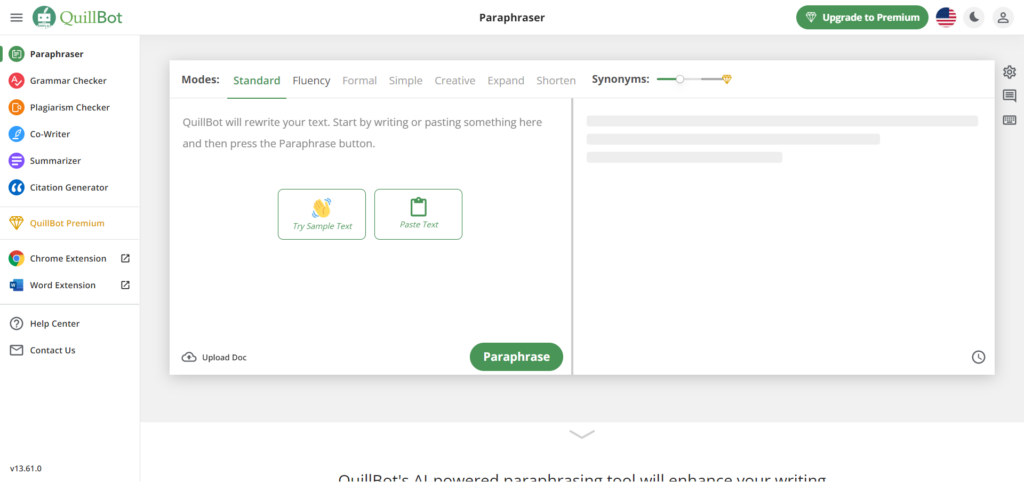
QuillBot is a sophisticated tool for paraphrasing text to prevent detection by AI systems. When you submit your article to QuillBot, its internal algorithm rephrases and alters the structure of each sentence without straying from the initial concept or storyline.
This process transforms your content, making it less recognizable by any AI detection mechanism due to constant changes in textual features and patterns. Think of this as giving your written piece a stylish makeover while maintaining the core essence and message.
Using Grammarly for Rewriting and even Paraphrasing

Grammarly is widely known as an excellent grammar checker, but few understand that it’s also an effective tool for avoiding AI detection. This tool goes beyond correcting grammatical errors; it assists tremendously in rewriting sentences to revamp entire articles without compromising readability or meaning.
By utilizing Grammarly’s intricate algorithms, you can rephrase content down to subtle details such as word spacing, punctuation usage, and more nuanced turns of phrase, all of which contribute significantly to bypassing AI scanners.
The beauty of Grammarly is that once you feed your text into its interface, not only does it give suggestions for refining syntax regularities but also ensures optimum language comprehension levels, providing perfect coherence with simplified rewrites at an approximately 9th-grade literacy standard!
Together, these digital helpers lighten the task of creating undetectable content. Nonetheless, remember that cooperation between humans and AI tools is fundamental, as only you can perfectly interpret non-literal expressions, contextual humor, or specific brand-aware nuances.
Common Questions About Bypassing AI Detection
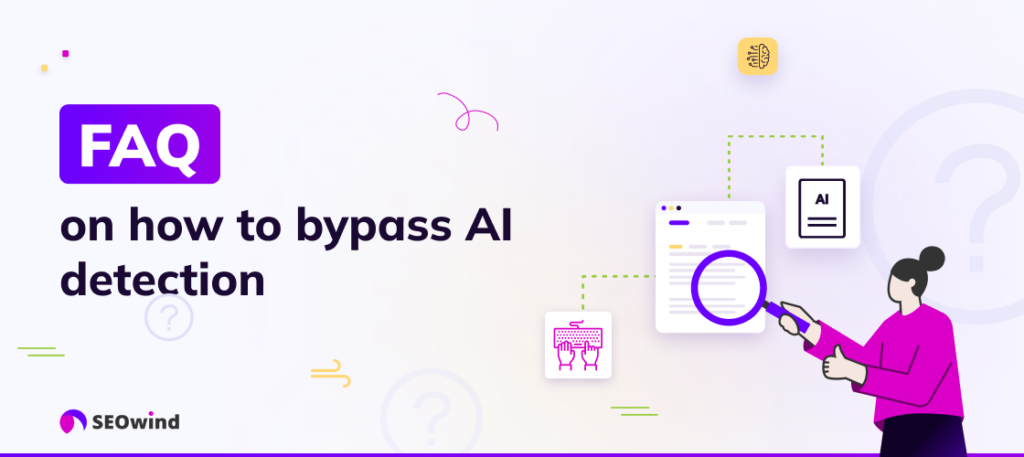
When mastering the art of dodging AI detection systems, you might find yourself grappling with several burning questions. That’s alright! Even as an experienced writer, I understand that these technologies can be quite puzzling. To help shed some light on these topics, let me tackle a few commonly asked inquiries about bypassing AI content detectors.
1. How do you escape AI detection?
One critical step to avoiding AI detection is varying your writing style. Use different sentence structures and diversify your vocabulary beyond your usual go-to words and phrases. You should also avoid repeating similar ideas or structures excessively throughout the text. Mix up how you present thoughts and ideas to slip under the radar successfully.
2. How do I make my AI content undetectable?
The trick to making your generated content stealthy is humanizing it as much as possible. This could include incorporating personal anecdotes or experiences into your content, using consistent brand voice and tone across all material, or even adopting colloquial language or slang tailored to your target audience.
3. What should I add to my prompts to bypass AI detection?
When crafting prompts aimed at dodging AI recognition systems, consider feeding them unique inputs like unconventional sentence constructions or innovative themes from less explored niches within your industry. Find ways to interject context clues that will guide the algorithm in producing more diverse responses.
I hope these answers clear up any doubts and provide insights that will assist you in comprehending not just how but also why we’re striving to co-exist symbiotically with burgeoning AI technology rather than fighting against it in our increasingly digitized world.
4. How Do You Escape AI Detection?
To avoid AI scrutiny, we should start by ensuring we possess a deeper understanding of how these systems work. They typically analyze for patterns, irregularities, and any nuances that indicate non-human input.
You could compare evading AI detection to playing an elaborate game of chess. Everything depends on anticipating your opponent’s moves (or, in this case, what the detecting system is looking for) and skillfully maneuvering around them.
Creativity is your secret weapon
Let’s start by leveraging our most human trait: creativity. No matter how sophisticated an AI system might be, originality continues to elude its grasp. Start embedding distinctive quirks into your content, such as observations based on personal experience or context-specific insights, that only humans can produce.
Varying content formats can help
Bear in mind that variety isn’t just the spice of life; it’s crucial when you’re trying to avoid AI detection, too! Use different content formats, each with sentence length and structure variations. This randomness mirrors human idiosyncrasies far better than anything AI can mimic at this point.
Clever usage of punctuation and syntax
Another feasible tactic is varying the syntax, the arrangement of words and phrases used to create well-formed sentences, and the punctuation you use. Unique combinations always throw computer programs for a loop due to their inability to fully comprehend semantic subtlety.
Just remember that knowledge without application isn’t very valuable!
Now, go ahead and implement this advice in your writing mission. These practices will help you bypass the keen eyes of AI detection systems and enrich your content along the way with engaging formats, increased creativity, and strategically positioned syntax deviations.
5. How do I make AI content undetectable?
When something is detectable by an AI detection system, it means that the system can recognize and identify it as being artificial or machine-generated. As such, achieving undetectability involves manipulating your output to appear so naturally human that even advanced technology would be convinced of its organic origin. It’s a blend of adopting specific writing strategies and using tools that maximize the human-like nature of your content while minimizing identifiable elements linked to AI mechanisms.
Firstly, remember to rephrase sentences. AI has become adept at identifying patterns within language structures commonly employed by text generation systems. Therefore, an effective way to dodge their scrutiny is by continuously rephrasing your sentence. Move around adjectives, change subject-verb arrangements, and explore passive constructs.
Always aim to write in an active voice whenever possible. This typically sounds more dynamic and human-like in written contexts, which confuses AI trackers trying to locate robotic textual footprints.
Simplicity also goes a long way since skilled humans generally write more succinctly than AI algorithms. Try to adopt a simple writing style. Stick to straightforward sentence structures with clear messages for better odds of avoiding detection.
Embrace variety in punctuation use and whitespace distribution because irregularities make the text seem less robotic. Present pictures through words rather than always using bullet point lists.
Finally, use natural human language variations, synonyms, and similar phrases instead of robotically repeating exact keywords over and over.
Show off your uniquely human instincts in the pursuit of genuine expression and leave no room for robotic rigidity that catches the attention of AI detectors!
The ultimate goal should be to publish truly unique content. You don’t just want your text to avoid detection by AI systems. Ideally, it would be practically indiscernible from authentic native English if scrutinized side-by-side!
6. What should I be adding to my prompts to bypass AI detection?
Evading the keen eyes of AI detectors becomes progressively tougher as technology advances. But with subtlety, expansive creativity, and insights into how these systems work, you can still slip through their scans quite effectively. Here’s an exploration of what your prompts should incorporate to achieve this goal.
- Add Contextual Complexity
- Introduce Unique Ideas
- Inject Personal Touches
- Ensure Semantic Variation
- Include Evidence-Based Information
Remember, coming off as too perfect and overly precise may trigger alerts for machine learning algorithms. Let’s face it: human writers make imperfect, nuanced, and contextual choices in language use. Perfect replication of those quirks poses a significant challenge even for the most advanced AI. To give your content a genuine, natural voice is a potent strategy for bypassing detection by AI systems.
7. How do you beat AI detectors?
Beating AI detection systems doesn’t have to feel like an uphill battle, and it’s far from impossible. With the proper knowledge, you can successfully navigate these sophisticated platforms. Here’s a step-by-step guide that outlines some techniques and practices that will help you outsmart AI content detectors.
- Use Paraphrasing Tools
Harnessing the power of paraphrasing tools is one effective way of dodging AI detectors. Tools like QuillBot can help tweak your text to make it unique without changing its original meaning. This leaves the AI detector none-the-wiser.
- Embrace Diversity in Word Choice
This strategy involves using synonyms or closely related terms to replace often-used words or phrases in your content. The idea is not just to switch similar words but to transform the entire sentence while preserving its core essence.
- Understand Well-Structured Sentences
Well-structured sentences are crucial to beating AI detectors. AI detectors might flag vague, ambiguous, or overly complex sentences as they generally prefer simple, clear sentences with proper grammar.
- Make Use of Human Review and Editing
While employing several strategies can significantly reduce AI detectability, human review remains unbeatable for now. After generating your work using advanced technology like AI, enlist the help of other writers or editors to lend their eyes.
Beating an AI detector does not mean resorting to manipulation or unethical means. Instead, we’re striving for authentic writing backed by creativity and user engagement but supplemented with clever use of technology! Let’s beat these detectors while being true authors ourselves.
8. How to Avoid AI Detection?
When we discuss bypassing AI detection, it’s essential to clarify one thing: it’s not about disguising malicious activity or crafting obscure strategies. Avoiding AI detection is more about maneuvering through a labyrinth with tact and wisdom, a challenge many content creators like myself often embrace. Doing so ensures your content remains personal, genuine, and uniquely human.
Let me guide you on this path with what I have come to call the “VEIL methodology,” which stands for Valuation, Evolution, Identification, and Liberation.
- Valuation – Acknowledge Unique Human Value
Firstly, understand that no sophisticated algorithm can entirely replicate our human touch. Our artistry and ingenuity are powerful tools AI cannot fully grasp. Exploit them! Experiment with creativity in your style while staying authentic.
- Evolution – Continual Learning
Secondly, being agile and adaptable to new methods will help you avoid the kind of static pattern that an AI might find suspicious. Stay updated on the latest research and trends regarding automated content detectors. As Albert Einstein aptly said, “Once you stop learning, you start dying.”
- Identification – Understand Your Targeted AI
The third step involves identifying the specific patterns that the targeted AI system may be looking for and obfuscating those indicators effectively within your work without harming its quality or honesty.
- Liberation – Free Your Content from the Automated Gaze
Lastly comes liberation, the process of disguising your work so deftly that it goes unnoticed by these perceptive algorithms but still rings true with human readers.
9. How to Trick an AI Detector?
You’re not alone if you’ve wondered how to trick an AI detector. It’s simpler than you might think! Here are some key strategies that have proven effective.
Master the Art of Rephrasing
First and foremost, mastering the art of rephrasing is essential. A paraphrasing tool like QuillBot could be helpful here. Rewrite your text to retain its original meaning but modify its structure enough to bypass the AI detection system. This involves restructuring sentences and paragraphs as well as replacing certain phrases with equivalent synonyms.
Be Creative With Punctuation and Spacing
Every little detail counts when trying to fool AI detectors. Something as seemingly insignificant as changing punctuation or tweaking spacing can make all the difference. Surprisingly, these changes can significantly alter how an AI system processes your content.
Work on Textual Cohesion
The coherence and cohesion of your text are crucial components in tricking an AI detector successfully. Try to achieve seamless transitions between ideas, ensuring each paragraph logically leads to the next.
However, excessive use of transitional words or phrases could raise red flags for many AIs. With that in mind, use them often enough to maintain a natural flow, yet not so much as to tip off any algorithms!
Understandably, mastering the art of tricking an AI detector isn’t something you’ll accomplish overnight. It requires practice and experimentation! As you refine your skills based on these strategies, you will become better at evading AI detection systems and improve as a content creator overall. After all, who doesn’t admire elegantly structured sentences and tightly woven arguments?
One last note: evading AI detection isn’t about deceiving anyone but simply ensuring your unique work receives the attention it deserves without being unfairly flagged or filtered by automated systems.
10. How to Fool AI Detectors?
So, you’re curious about how to fool AI detectors? Well, successful evasion requires a deep understanding of the systems at play and a few tricks up your sleeve. But don’t worry! I’m here to share some techniques that have worked really well for me.
Firstly, remember that AIs heavily depend on patterns for detection. They comb through content, spotting repeated structures or common phrases with unerring accuracy. Therefore, our first job is to break these habitual writing patterns.
- Rephrase sentence structure: This method seems straightforward but can be tricky in practice because we all have unique writing styles. It’s like our signature on the text document! To fool AI detectors, however, changing your typical sentence structure is vital. Start sentences differently and adjust word positions within a sentence to create variety.
- Change punctuation and whitespace: Once again, this entails breaking away from norms in how you use punctuation while also altering the spaces between words or lines.
Next comes the more intricate step: dealing with language processing and AI systems semantics.
- Use synonyms strategically: Although this strategy might seem rudimentary, its power lies in subtlety. Substituting one synonym for another can help avoid pattern-mapping employed by sophisticated machines.
- Eliminate repetitiveness: Avoid the frequent repetition of keywords or phrases, as constant reiteration sticks out like a sore thumb to AI detectors hunting for anomalies in text data.
- Flaunt domain knowledge: By inserting your expertise into content, you endow it with an irreplaceable human touch, making it less algorithmic. Exclusive insights are more challenging for AI detection systems to flag.
- Narrate personal stories or anecdotes: Adding personalized narratives lends authenticity and throws off tracking algorithms because of their subjective nature and irregular patterns.
Remember, fooling AI detectors is not about gaming the system. Rather, it’s about refining your content to make it less predictable and machine-like.
11. How to not be detected by an AI detector?
Undoubtedly, you’re curious about how you can craft content that won’t raise any red flags for AI detectors. Here, we dive into the practical aspects of eluding those pesky AI detection algorithms. This unique craft requires balancing originality and intelligibility while navigating algorithmic pitfalls.
Firstly, reduce the predictability of your writing pattern. One method for doing so involves consciously altering your sentence structures throughout your text. Make it a habit of switching between short, concise sentences and more complex structures.
Secondly, go beyond plain semantics. Explore various synonyms, analogies, or even metaphors. Replacing commonly used words with less used but similar-meaning options conceals content origin from an AI perspective while preserving comprehension for a human reader.
Perhaps most important is integrating a touch of human imperfection into your work. Machines learn from patterns; they expect perfection owing to their programmed binary nature. Throwing in occasional deliberate mistakes, such as double spaces after full stops or slight grammar inconsistencies, could serve as excellent disguises against potential detection.
Remember: This might work to avoid AI detection but will make them seem less professional and likely scare off audience members.
Also, remember to stay up-to-date with evolving technology trends relevant to AI detection systems. Familiarize yourself with the latest methods these systems use for anomaly identification and equip yourself with counter-strategies that ensure you remain undetectable.
Beating an AI detector is not just about masking one’s writing style; it requires adapting to an ever-improving strategy shaped by ongoing learning and staying steps ahead of rapidly advancing technologies.
12. How not to have AI-generated text detected?
Let’s shift our perspective a bit. Instead of being defensive and constantly trying to bypass AI detection, have you ever thought about playing offense? Making your text so natural and human-like that no AI detector can flag it as machine-generated content is an exciting yet challenging task.
The Art of Imitating Human Writing
AI has dramatically evolved over the years to become capable of generating sophisticated content remarkably close to a human’s writing style. However, some tell-tale signs often give away machine-manufactured lines.
What if we could seamlessly blend these differences? Let’s delve deeper into techniques you can utilize to become undetectable to AI:
Use Inconsistency
As humans, our writing styles aren’t always consistent; they change based on mood, subject matter, or even the time of day. This inconsistency is often absent in AI-generated texts, which maintain a steady tone throughout a piece of content. One technique is introducing slight variations in style and occasional verbosity or simplicity into your sentences.
Emotion Injection
Emotional nuance is something machines cannot perfectly replicate at this point. Therefore, adding emotional reactions or reflections pertinent to the context makes your output more organic, thereby efficiently fooling the AI detectors.
Wordplay and Metaphors
We humans love good wordplay and metaphors every now and then. They bring flavor to otherwise everyday conversations! This creative art is something AI does not excel at just yet. Incorporate some playful analogies related to the topic for a professional yet engaging piece!
Include Personal Touches
Last, personalize your content. Humans have unique experiences that are reflected in our narratives. Infuse personal anecdotes relevant to the content you’re developing. Who knows how many people might resonate with them?
By assimilating such inherently human traits into your content, you create a sophisticated blend of human-AI collaboration that eventually leads to an artistic camouflage that makes it challenging, if not impossible, for an AI detector to mark it as machine-generated. While machines constantly learn and evolve, we have the advantage of subjective consciousness. We just need to harness it!
13. How to reduce AI detection?
Can you imagine trying to creep through a forest without stirring the leaves underfoot or causing birds to take flight suddenly? That’s not too dissimilar to what we’re trying to do when we talk about reducing AI detection. We can’t entirely hide our tracks, but with knowledge and finesse, we can certainly tread more lightly.
Understand AI Rules
Firstly, you must familiarize yourself with how AI algorithms function. Remember that these systems are programmed to identify patterns specific to human language and machine-generated text. By digging into the mechanics of these processes, you can better understand their rules and subsequently use this information to your advantage.
Write Naturally
One rule worth mentioning concerns conversation flow. AI models are equipped with linguistically informed models that easily spot robotic lingo or repetitive patterns. Therefore, ensure your content unfolds naturally.
Consider conversations you have every day; they aren’t scripted and instead follow an organic back-and-forth rhythm. Implementing narrative techniques mimicking natural human conversation can help you deftly sidestep some AI tripwires.
Vary Your Content Creation
Keep things unpredictable! Mix up your style occasionally and experiment with various tones or perspectives. This technique serves two purposes: it helps create engaging content while simultaneously confusing AI detectors looking for consistent form and structure.
For instance, if writing blogs is part of your routine, occasionally add case studies or interviews into the mix.
Employ Tools Wisely
Take full advantage of tools like Grammarly and QuillBot, which are designed specifically for rewriting or paraphrasing content. These may assist in creating diverse structures in your text, making it harder for AI detection mechanisms to target your written material.
Keep in mind that even while using such tools, merely running text through them won’t necessarily elude detection. Instead, leverage these resources mindfully because fooling AI detectors requires both the sophisticated technology they offer and your distinct human input.
Carefully navigate your way to success in reducing AI detection by understanding how AI works and how you can outsmart it. Write naturally, diversify your creations, and use tools as aids rather than crutches.


